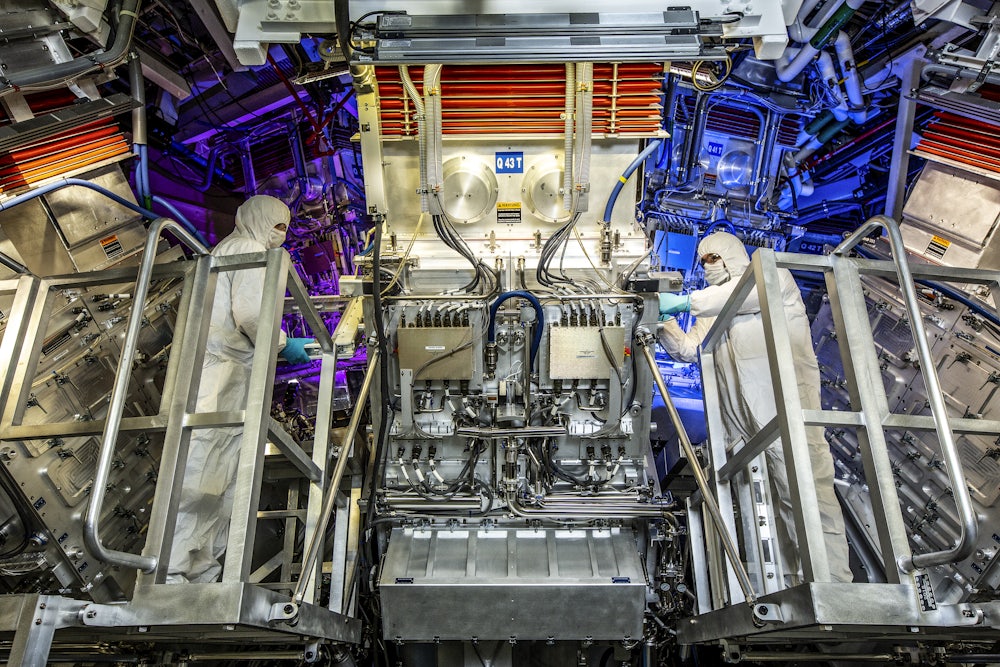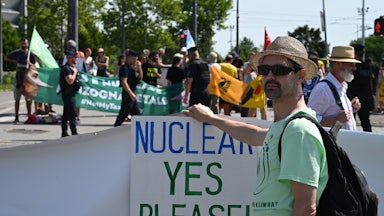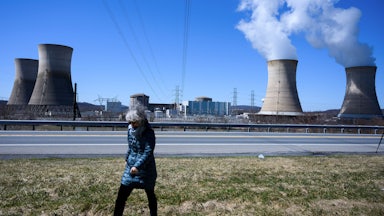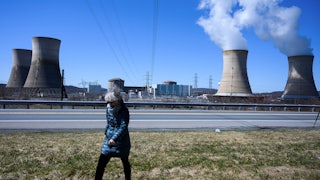There are three things worth knowing about this week’s startling announcement of a breakthrough in nuclear fusion technology. First, this could one day offer a huge new source of energy. Second, it won’t come in time to change the dynamics of the current climate crisis. And third, don’t expect advocates of conventional nuclear power—i.e. fission rather than fusion—to cheer this news. They’re more likely miffed.
On Tuesday, scientists at Lawrence Livermore National Laboratory National Ignition Facility announced what’s being touted as the world’s first nuclear fusion “ignition,” the crossing of the threshold at which the amount of energy going into a reaction is lower than the amount of energy generated. Nuclear fusion replicates the process inside stars, where multiple atoms join to form a larger one. Unlike nuclear fission, which requires expensive materials like uranium and releases heat and radiation—the stuff people dislike about current nuclear power—fusion uses cheap and abundant hydrogen, producing little to no radiation, depending on which isotopes are used.
The fact that laboratories have now managed net energy production this way is huge, although the usual caveats apply: This doesn’t mean you can now charge your phone with fusion energy, nor can fusion replace things like wind, solar, or indeed its cousin nuclear fission, in our short-term efforts to stave off climate change.
According to Mark Wenman, reader in nuclear materials at Imperial College London, this means fusion “will undoubtedly be the king of green energy technologies.” That won’t happen until the 2040s or later though. Fusion could have a huge positive impact on the environment, but “not an immediate one that we desperately need.”
It seems that ignition has suddenly ushered fusion into the realm of things that are real, but still ramping up. That’s a subtle but significant change in status from its former banishment to the realm of Trekkie fantasies and wishing.
Fusion’s ramp-up will now occur alongside the supposed reramp-up of fission plants touted by many ecocontrarians who believe conventional nuclear power is the only viable path from the ecologically horrific present to a green energy future. Given that commercial fission already exists, and fusion is still experimental, a race is now on that could one day make current claims about the viability—or indeed, necessity—of greater investment in fission look like a perplexing detour.
Most people, of course, probably don’t think of nuclear fusion and nuclear fission as rival technologies vying against one another; they’re different enough that they’re rarely even mentioned in the same TED talk. It’s worth noting that there are prominent backers of both fission and fusion, like Bill Gates. But for many nuclear energy enthusiasts, this news drops into a complicated topography of nuclear advocacy at a pivotal moment, as many conventional fission plants face closure.
Michael Shellenberger, undoubtedly America’s foremost advocate for fission energy, has famously staked out an idiosyncratic position on the topic, arguing that renewables are a distraction, and fission is the only realistic clean energy source for no-nonsense grown-ups. He also believes fusion has no future if we don’t first prioritize fission. He tweeted in 2020, “We’ll never have fusion or alt-nuclear if we allow our existing nuclear plants to shut down.”
As of this writing, few staunchly pronuclear Twitter accounts, such as @Nuclear4Climate, @moms4nuclear, or Shellenberger himself, have tweeted anything at all about the Lawrence Livermore ignition breakthrough. U.K.-based nuclear advocate Jeremy Gordon tweeted, “Positive heat output from fusion - yay!” followed immediately by his doubts about fusion.
Breakthrough or not, the gap in feasibility between the experiment on December 5, and commercial fusion energy remains colossal. This latest setup, which utilized a technique called inertial confinement fusion, involved blasting fusion fuel into smithereens with lasers. But this is perhaps best understood as a demonstration, and not even a clear stepping stone on the path to fusion electricity generation. According to Brian Appelbe, a physicist at Imperial College London who performed modeling for the Lawrence Livermore fusion experiments, “The laser was built to just fire once per day,” and if this technology were to be used as a power source, it “would need a laser that fired about once per second.”
To be more explicit, a two-megajoule laser produced about three megajoules of fusion energy. But as Kim Budil, director of the Lawrence Livermore National Laboratory, explained at Tuesday’s press conference, “The laser requires about 300 megajoules of energy from the wall.” If fusion is going to be a source of commercial energy, it needs to be more than 100 times as efficient as this, and reaching that promised land may require magnetic confinement fusion, a completely different type of fusion reactor.
So while inertial confinement just achieved a sort of victory over its competing method, it’s much too early to say this type of fusion is the winner. Instead, it’s a bit like Thomas Edison trouncing Nicola Tesla in the alternating current versus direct current format war. The Nicola Tesla in this (friendly) competition is still very much in the game, because the long-term International Thermonuclear Experimental Reactor, or ITER, project in southern France will use magnetic confinement rather than inertial confinement, and that experiment is “designed to achieve a net gain of 10x energy sometime in the 2030s,” according to Wenman.
The path forward is a winding one, to say the least. But two crucial ingredients, excitement and money, are imbuing fusion—and inertial confinement fusion in particular—with its newfound sense of inevitability. This latest experiment has been “impressive relative to its modest government-provided research budget,” Oxford physicist Gianluca Gregori told me. “These recent results from [the National Ignition Facility] may further increase the interest of private investors seeing that the fundamental physics of the proposed approach is sound. And with that, new ideas for higher fusion gain may emerge—although we don’t know yet which of the approaches may lead to a commercial reactor.”
Still, when it comes to battling climate change, Wenman told me fission is better positioned serve that purpose than fusion right now—largely because nuclear fission plants already exist, and the world can’t afford to wait any longer to wind down fossil fuels. He also noted, however, that fusion will have at least one distinct advantage when it finally reaches viability: “Unlike fission, it cannot suffer catastrophic accidents or produce very long-lived—greater than 10,000 years—nuclear waste.”
It’s easy to see why fission advocates find these kinds of pronouncements frustrating: Fission has been a viable source of electricity since 1951. Bill Gates owns a fission power company. The New York Times publishes the occasional op-ed touting its ability to “save the world.” And yet, it’s struggling. Ambivalent environmentalists are now frequently conceding that keeping fission plants open and generating low-carbon energy is better than closing them, but 12 fission power plants in the U.S. have nonetheless been shut down since 2012. Only one new U.S. fission reactor has gone online in the entire twenty-first century: a unit at Watts Bar Nuclear Plant in Tennessee. And that took 43 years to build.
If the excited physicists are right about the future of fusion-based electricity, we’ll start to see fusion power plants in about the next 25 years. Fusion entrepreneur Melanie Windridge told The Washington Post the latest fusion news was “like the Kitty Hawk moment for the Wright brothers”—but that strained analogy doesn’t take into account the people all over the world long past their wits’ end, waiting for clean energy. So it’s like a Kitty Hawk moment during which billions of people are already impatiently waiting at terminals for their overdue flights. It’s not for nothing that the joke about fusion has for decades been: “It’s thirty years away, and it always will be.”
But this is the counterintuitive truth to keep in mind: Even if commercial viability for fusion takes another 30 years, that’s still shorter than 43 it took to get the fission plant in Tennessee.










